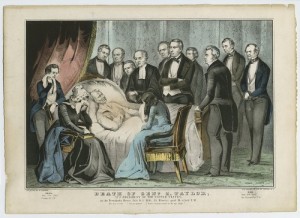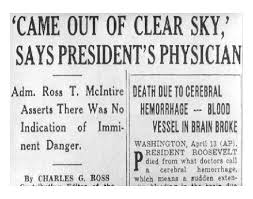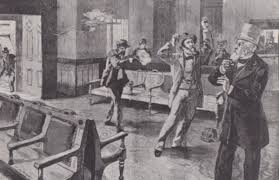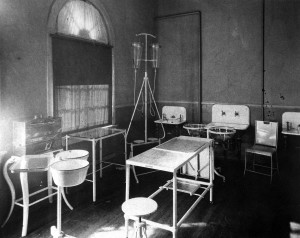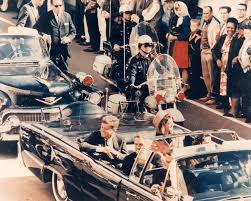When Hillary Clinton collapsed it caught a snoozing news cycle by surprise. She has pneumonia – a general term for inflammation of the lungs most often caused by an infection. That infection is probably caused by an organism called mycoplasma – the smallest living organism, and is responsible for the two million plus cases of walking pneumonia a year in the US. Pneumonia can also be caused by chemical inflammation, such as acid even from acid reflux.
Since pneumonia is such a general term it can range from the most benign to very serious. Modern medicine has decreased the death rate from pneumonia but it is still one of the “final common pathways” of death. Before vaccinations it was “an old person’s friend.” Pneumonia often taking the person who had been suffering from heart disease or cancer. Of the 30,000 people who die a year from the flu usually die as a result of the lung inflammation from the virus.
Is her pneumonia contagious? Most of them are not. The ones that are include those caused by TB and most viral pneumonias. Bacterial pneumonias are not.
That she has kept up a campaign schedule in spite of pneumonia for at least a few days is quite impressive. She will recover fairly quickly. I doubt I could keep up with her 16 hour a day schedule. But conspiracy theories abound, in spite of a 24 hour news cycle covering her every move.
What about her other issues?
She requires thyroid medicine, a condition that affects 1 in every 200 people and is managed easily with replacement that she is taking.
She takes a blood thinner – coumadin, because she suffered a deep vein thrombosis of her leg two times. The blood thinner is also prescribed because she developed a clot near one of her sinuses in her brain. The coumadin level is managed by taking periodic blood tests to make certain that her blood isn’t too thin – making her prone to bleed, or too thick – making her prone to clot.
She had an ear infection that required tubes be placed in the ear – which is common for kids and can happen with adults. Nothing long-term.
She had a concussion, that did leave her with some double vision for a bit, but is over that issue. Concussions resolve quickly – you see how fast NFL players return to the field.
She has kept up a campaign schedule of 16 hour days from 2015 and beyond. When she was secretary of state she visited many countries and was well regarded. Her stamina is outstanding.
Still, reflecting upon the health of the 44 presidents the United States, a stunning 18 per cent have died in office. Modern medicine would have prevented most of them from dying.
Presidents and Death
Four president’s have died in office without being assassinated. For all of them, their deaths would have been prevented by modern medicine.
William Henry Harrison – died 1841. Pneumonia and Bleeding.
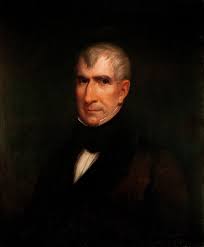
The first president to die in office was William Henry Harrison. Pneumonia exacerbated by bleeding led to his death.
The first was William Henry Harrison, who died of pneumonia in 1841. Some point out his two hour speech after being elected, but it was three weeks later that he became ill with a serious pneumonia. He died 30 days after taking office, so he was not only the first president to die in office, but also served the shortest period of time. The doctor’s who treated him used bleeding, herbs, and other nonsense leading to his rapid demise. It is odd that in the modern era with antibiotics we still have people who practice as they did in 1841, without science and with a lot of nonsense.
Zachary Taylor – died 1850. Food Poisoning.
Zachary Taylor, the second president to die in office, died in 1850 after eating some raw milk with cherries. Probably from typhoid fever secondary to food poisoning. Conspiracy theories were rampant then, as Taylor was opposed to slavery the one theory is that he was poisoned. In 1991 his remains were tested, and no poison was found. No doubt how he was treated in those days: opium, ipecac, quinine, as well as cupping (like Michael Phelps) and bleeding led to his demise. Zachary Taylor provides a reason not to drink unpasteurized milk.
Warren Harding – died 1921. Food Poisoning.
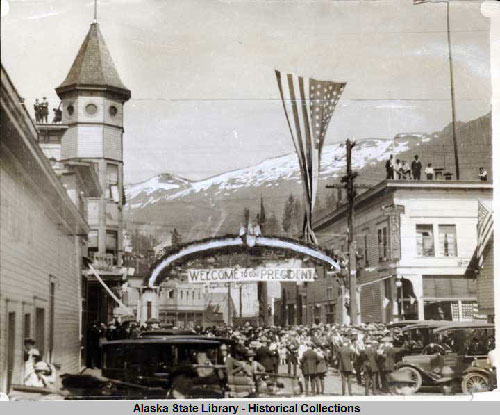
President Harding, the only President to visit my hometown of Ketchikan – was it our crab that killed him?
Warren Harding died after two years in office in 1921. The speculation is food poisoning after a trip to Alaska. He had many signs of exhaustion, including not finishing a round of golf. In my hometown of Ketchikan, Alaska it was widely said he died from the bad crab he was served at one of the local restaurants. While that makes my hometown famous, had Harding been treated with intravenous fluids and antibiotics he would have survived – sadly antibiotics were not available, but intravenous fluids were.
Franklin Roosevelt – died 1945. Stroke secondary to heart failure.
Franklin Roosevelt died in office of a stroke, and had been suffering from congestive heart failure with a very high blood pressure for some time. Because his medical condition was famously protected by the press, it came as a shock when he died. Physicians did not have good treatments for blood pressure, which today would result in immediate hospitalization. His blood pressure was listed in the last year as sometimes being 300/200. Today blood pressure is easily controlled with a wide variety of medications. In those days the treatment of blood pressure was “controversial,” but his death helped usher in the modern treatment of blood pressure.
Three of the presidents who were shot would have been saved by modern medicine
Abraham Lincoln – died 1865. Assassination by gunshot to the head.
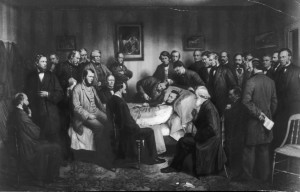
The famous painting of the deathbed of President Lincoln. Today his injury would not have killed him
Four other presidents were assassinated starting with Lincoln in 1865. Although they tried to save him by probing his skull to relieve pressure on his brain he died from the injury that the doctors at the time said was “mortal.” Today, with that same injury, Lincoln would be rushed to a trauma center and undergo surgery on his brain that would have likely resulted in saving his life and allowing him to return most function.
James Garfield – died 1881. Assassination by gunshot and medical malpractice.
President Garfield’s assassination was the start of his death, but the medical malpractice after his death contributed more to his demise than the gunshot (he spent days being probed, given enemas, and malpractice from a doctor who re-named his first name to “Doctor”). The physician, Dr. D. Willard Bliss, was a civil war surgeon who believed that if you could remove the bullet you could save the soldier. He didn’t believe in the “germ” theory and tortured President Garfield a number of times by going after the bullet with unsterilized probes. Garfield died 88 days later, from multiple infections from the attempts to remove the bullet. When his assassin went to trial his defense was that he didn’t kill the president, but medical malpractice did. He was probably right. Even by the standards of 1880 Dr. Bliss was considered a quack.
The idea that removing the bullet leads to survival was a correlation not a causation. If the bullet is easily found and removed a person is likely to survive. But probing wounds with unsterile instruments is never a good idea.
William McKinley – died 1901. Assassination by gunshot and pancreatitis.
McKinley’s assassination in 1901 was noted for his fast operation and discharge (modern medicine at its finest). McKinley was attending the World’s Exposition in 1901, famous for showing off electricity. The Exposition had an operating room on the premise. After McKinley was shot he was quickly transported to an operating room by an electric car. At surgery the bullet in his stomach was removed and the stomach was repaired with the best modern medicine. McKinley was discharged 3.5 hours after he was shot. Unfortunately he developed an inflammation of his pancreas and died later from those complications. In modern medical times treatment of pancreatitis is with intravenous fluids and monitoring, not available even though he had excellent surgical care.
John F. Kennedy – died 1963. Fatal gunshot wound.
The death of John Kennedy continued the long line of speculation as to who killed him and what conspiracy was involved. By all notes the fatal head wound was instantly fatal. One of my surgical mentors was present when Kennedy arrived at Parkland Hospital and noted that the president was “deader than a doornail.” Still they attempted CPR on the president because the surgeons at the time recognized what it would mean to the country to have this young leader die.
When counting our 44 presidents, 8 have died in office, 4 from guns, 2 from from food poisoning, and 1 from complications of heart failure. That is a stunning 18 per cent! But only one of them died from a diagnosable condition that would have been known on the campaign trail.
But as a physician, of those presidents who died in office died from “modern” medicine at the time. Of the eight who died, seven would likely have survived if treated by today’s standards.

